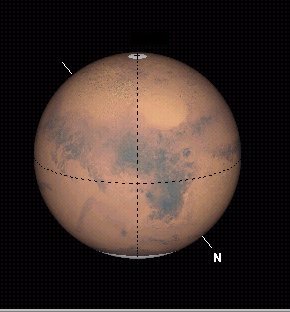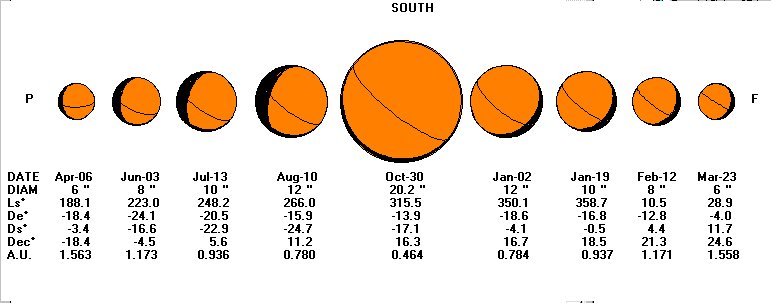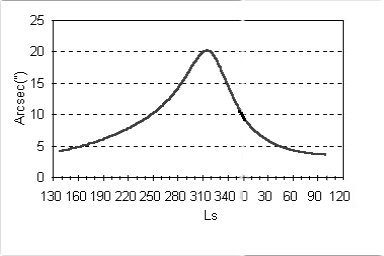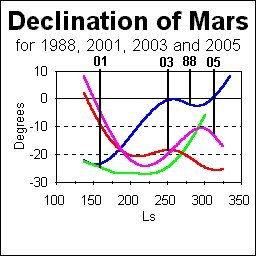
ABSTRACT
Mars will appear smaller in 2005 than it was in 2003. During closest-approach in 2005, Mars will be 4.9 seconds of arc (arcsec) smaller in apparent diameter than it was at closest approach in 2003; however, it will be 32° higher in the sky for northern hemisphere observers, and that will tend to negate the effects of a smaller apparent diameter. Always an intriguing world, Mars offers both casual and serious observers many challenges and delights. It also provides astronomers a laboratory to study the atmosphere and surface of another planet, including the behavior of condensates and their effects on its atmosphere and surface.
A major change in the presentation of pre-apparition Mars reports has been initiated and information for observing Mars during a typical apparition is presented in a separate report titled, "General Information for Apparitions of Mars." This report can be found on the Internet at URL: http://www.alpo-astronomy.org/jbeish/General_Info_Mars.htm
In the pre-apparition reports, the observer will find the motion of Mars in our sky, the characteristics for that particular apparition, information pertaining to the polar caps, and any special events that may be observed during that particular apparition. A calendar of events contains cardinal dates for seasonal activity and orbital information of Mars.
Prior to the 2001 apparition of Mars, we considered quality visual observations practical once the apparent diameter of the Martian disk exceeds 6 arcsec. However, with the advent of CCD camera technology, the amateur can produce useful images of Mars when it is as small as 3.5 arcsec. Early in an apparition, Mars rises in the east (morning sky) and sets with the rotation of the Earth in the west (evening sky). During the past few apparitions (2001-03), observers began to take CCD images when Mars was only 32° away from the Sun. Since Mars was only a visual magnitude of ~1.8 then, the planet would have been difficult to locate during bright twilight hours.
An apparition of Mars begins when the planet emerges from the glare of the Sun shortly after conjunction. Mars will be in conjunction with the Sun on September 15, 2004 (87° Longitude System [Ls]). Even though the Red Planet will not be occulted by the Sun, it still will be too close to be seen. The declination of Mars will be ~0.9° north of the Sun at the time of conjunction.
The apparent declination of Mars began at -20.9° in January 2005, then continued southward to -23.7° by mid-February. Mars appeared low in the sky for observers in the mid northern latitudes, then slowly ascended northward in declination to reach the celestial equator on June 21. It continues northward after that and remains above the celestial equator for the remainder of the apparition. This is good news for those observing from both the northern and southern hemispheres though, because Mars is seen high in their respective skies. By July 13, a -0.3 visual magnitude Mars was seen rising early in the morning sky in the constellation Pisces. The planet was at western quadrature (90° west of the Sun) and the phase or terminator was at its widest (47°).
Just over a year after conjunction, from October 01 2005 (298° Ls) through December 11, 2005 (338° Ls), Mars goes through a period of retrogression, or retrograde motion, against the background stars. Each night during this brief period, the Red Planet will appear to move backwards toward the western sky from the constellation Taurus into Aries.
Since the Martian year is about 687 Earth days long -- nearly twice as long as our year -- the Martian seasons are similarly extended. While the Earth's seasons are nearly equal in duration, the Martian seasons can vary by as much as 52 days from each other due to that planet's greater orbital eccentricity, as shown in Figure 1.

Figure 1. A heliographic chart of the orbits of Mars and the Earth showing the relative seasons of both planets in the planetocentric longitude system Ls. Graphic Ephemeris for the 2005 Perihelic Apparition of Mars. Original graph prepared by C.F. Capen and modified by J.D. Beish.
Another general rule for predicting oppositions of Mars is from the following: the planet has an approximate 15.8-year periodic opposition cycle, which consists of three or four Aphelic oppositions and three consecutive Perihelic oppositions. Perihelic oppositions are also called "favorable" because the Earth and Mars come closest to each other on those occasions. We sometimes refer to this as the seven Martian synodic periods. This cycle is repeated every 79 years (+/-4 to 5 days) and if one were to live long enough, one would see this cycle nearly replicated in approximately 284 years. The 2005 Mars apparition is considered perihelic, because the orbital longitude at opposition will be only 70° from the perihelion longitude (250°).
Closest approach occurs at 04:21 UT on October 30, 2005 (315° Ls) with an apparent planetary disk diameter of 20.2 arcsec at a distance of 0.464237705619 Astronomical Units (AU) 69,448,972 km (43,153,504 miles. [NOTE: one AU equals 149,597,870 km (92,955,621 miles)]. It should also be noted that closest approach between the Earth and Mars is not necessarily coincident with the time of opposition, but varies by as much as two weeks.
Opposition occurs thirteen and a half months after conjunction, when Mars is on the opposite side of the Earth from the Sun. At that time, the two planets will lie nearly in a straight line with respect to the Sun. About five weeks after that, retrogression begins. Opposition will occur at 08:20 UT on November 07, 2005 (319.8° Ls; Figure 2), with an apparent planetary disk diameter of 19.9 arcsec. Mars will remain visible for visible for over 11 months after opposition, then becomes lost in the glare of the Sun again (October 11, 2006) as it approaches the next conjunction (October 23, 2006). The cycle is complete in 780 Earth days.

Figure 2. A simulated view of the appearance of Mars during opposition at 0824 UT on November 07, 2005 (319.8° Ls).
The observable disk diameter of Mars will be greater than 6 arcsec from April 07, 2005 [188.7° Ls, -19.6° d]and will not fall below this apparent diameter until March 24, 2006 (29.3° Ls), lasting 11 and a half months or 200° Ls. During a similar profile in 2003, Mars began at 6 arcsec on February 25, 2003 [142.9° Ls, -23.3° d ] and continued until February 19, 2004 [352.1° Ls, 15.6° d], equaling almost a year or 209° Ls. Imaging by CCD devices may begin with a disk diameter of 4 arcsec or less, commencing on December 17, 2004.
During closest approach in 2005, the apparent
diameter of Mars will be nearly 5 arcsec smaller than it was at the same
period in 2003; however, it will be 32° higher in the sky - much better
for observing the Red Planet - helping to make up for the smaller size.
The Sub-Earth (De, also known as the Areocentric
declination of Earth) and Sub-Solar (Ds) points are graphically represented
in Figure 3 and 4. The 2005 and 2006 Physical Ephemeris of Mars is tabulated
at the following URL: http://www.tnni.net/~dustymars/eph05_06.html
Figure 5 graphically illustrates the ephemeris
of Mars for 2005, showing the apparent diameter of the planet. Figure 6
illustrates the Martian apparitions for 1988, 2001, 2003, and 2005.
A glossary of terms appears at the end
of the ephemeris table.

Figure 3. As it approaches Earth, Mars will swell from a small apparent disk of 6² in April 2005 to a maximum diameter of 20.2'' on October 30, 2005, then shrink as it moves away. Closest approach occurs on October 30, 2005 (Opposition November 7, 2005). April 2005 through February 2006 are the prime observing months.

Figure 4. Graphic Ephemeris of Mars during the 2005 apparition from January 1, 2005 through December 31, 2005. Opposition and 6 arcsec apparent diameter range arc indicated. Plot illustrates the Declination (green line), the latitude of the Sub-Earth point (De) or the apparent tilt (black line) in Areocentric degrees, and the latitude of the Sub-Solar point (brown line) in Areocentric degrees. The Areocentric longitude (Ls) of the Sun, shown along the bottom edge of the graph defines the Martian seasonal date. The value of Ls is 0° at the vernal equinox of the northern hemisphere, 70° when Mars is at aphelion, and 90° at the summer solstice of the northern hemisphere 250° when Mars is at perihelion, and 180° is northern autumn.

Figure 5. Graphic Ephemeris of Mars from January 1, 2005 through December 31, 2005. Plot illustrates the apparent diameter of Mars in arcsec. The Areocentric longitude (Ls) of the Sun, shown along the bottom edge of the graph defines the Martian seasonal date.

Figure 6. Graphic plot comparing the declination of Mars during the 1988, 2001, 2003 and 2005 apparitions. The Areocentric longitude (Ls) of the Sun, shown along the bottom edge of the graph, defines the Martian seasonal date. Oppositions years are shown at top of vertical lines. Opposition date 1988 [280° Ls] - (blue line), for 2001[177° Ls] - (green line), 2003[249° Ls] - (orange line), and 2005 [320° Ls] - (violet line).
THE SOUTH POLAR REGION
Astronomers will have an excellent view of the prominent South Polar Cap (SPC) during most of the next apparition, because it will be tilted earthward during most of 2005 and the first two months of 2006. On January 29, 2005 the Martian South Polar Region (SPR) began to tilt toward the Earth and will remain so for the remainder of the apparition. Also, except for the effect of the terminator on the polar cap, it will be in sunlight until opposition and because the Ds will then begin to move northward, or more positive, with respect to the De. After that, the South Pole will be in the shadow of the southern portion of the limb terminator.
Until May 26, 2005, the De will vary from 0° to -24.2°. After a week's pause at -24.2°, it will dip down to -10.5° on September 26. By opposition, it will slip southward -15.3° and continue to -18.8° by December 31. This will allow the observation of Antarctic hazes and the spring-summer shrinking of the SPC.
In the first weeks in March 2005 (177-184° Ls), the SPC should begin to clear its hood, and the first glimpse of the "Life-Saver Effect" should be visible. By the third week in April (195° Ls), the SPC should be free of its hood, enough so to begin micrometer measurements. For more detailed information on the south polar cap click to the URL: http://www.tnni.net/~dustymars/SPR.htm
DUST STORMS
Observations of Mars indicate that major dust storms tend to occur more frequently when Mars is closest to the Sun - during southern hemisphere spring and summer. While predicting these events is nearly impossible to do, our studies show that the Martian dusty season should begin about the first week in July (241° Ls) through the middle of August 2005 (270° Ls). The highest probability of dust storms was on or about July 24, 2005 (255° Ls) and a sensitive area for the development of dust storms is in northwest Hellas.
Massive, "planet-encircling" storms usually occur in the southern hemisphere summer and that will come by the end of October 2005 (315° Ls). Observers should be alert for dust clouds in the northeast Hellas Basin, the Serpentis-Noachis region, and the Solis Lacus region. If the Red Planet behaves as it did in 2001 and 2003, then 2005 may be a time when Mars may be very dusty indeed! For more detailed information on Martian dust storms, refer to the URL http://www.tnni.net/~dustymars/2003_DUST.htm
SPECIAL EVENTS
For those interested in catching a glimpse of possible "flashes" from the surface of Mars, there is one remaining period when possible "flashes" may be seen. It will be when the De and Ds are coincident, on or about November 08, 2005. Refer to Table 1 for dates when De = Ds ±1.0°:
Table 1. Dates and times of possible "flashes" from the surface of Mars.
| Date | Rise | Transit (EST) | De | Ds | De - Ds | i |
| November 06 | 2235 | 0519 (0119) | -15.1 | -15.9 | 0.8 | 1.3 |
| November 07 | 2231 | 0514 (0114) | -15.3 | -15.7 | 0.4 | 0.5 |
| November 08 | 2225 | 0508 (0108) | -15.5 | -15.5 | 0.0 | 0.6 |
| November 09 | 2220 | 0503 (0103) | -15.6 | -15.3 | -0.3 | 1.5 |
| November 10 | 2215 | 0458 (0058) | -15.8 | -15.1 | -0.7 | 2.4 |
Table 2. CALENDAR OF EVENTS -- MARS, 2005
| DATE | PHYSICAL | REMARKS |
| 2005 Mar 23 | Ls 180.1°
De -15.2° Ds -00.0° RA 20:16 Dec -20.7° A.Dia 5.6’’ |
Equinox - Northern Autumn/Southern Spring. South Polar Cap (SPC) maximum diameter, subtending ~ 60.5° W. Is the North Polar Hood present. Does SPH or frost cover Hellas? Hellas should begin to clear and darken. Are W-clouds present? South cap emerges from darkness of Winter. SPH thinning and forms "Life Saver Effect." |
| 2005 Apr 07 | Ls 188.7°
De -18.4° Ds -03.6° RA 21:01 Dec -18.2° A.Dia 6’’ |
Apparition begins for visual observers using 4-inch to 8-inch apertures telescopes and up. Begin low-resolution CCD imaging. Views of surface details not well defined. Southern clouds frequent. SPH hood thinning. Eastern Syrtis Major fading and broading? White areas brighter? Syrtis Major thinner and darker? Surface increasing in contrast. Hellas bright? Northern clouds frequent. Are both polar hoods visible? SPC should be free of its hood. SPC shrinking ? Possible W-clouds in Tharsis-Amazonis. NPH bright. White areas brighter? (SPC W ~58.1° ±5.5°). |
| 2005 Apr 27 | Ls 200°
De -22.0° Ds -8.4° RA 21:59 Dec -13.9° A.Dia 6.6’’ |
Bright SPC projection Novissima
Thyle 300° - 330° areographic longitude. Dark rift Rima Augusta
connected from 60° to 270° longitude. Rima Australis visible in
SPC (290°-350°W)? W-clouds possible. SPC bright projection Argenteus
Mons (10° W - 20° W). SPC Dust clouds in Serpentis-Hellespontus,
in Hellas or Noachis?
(SPC W ~52.8° ±3.5°). |
| 2005 May 13 | Ls 210°
De -23.6° Ds -12.1° RA 22:43 Dec -10.0° A.Dia 7.2’’ |
Is the Rima Australis visible
in SPC (290°-350°W)? SPC bright projection Argenteus Mons (10°-20°W).
SPC Novissima Thyle (300°-330°W) projection present? Look for possible
small dust clouds in Serpentis-Hellespontus.
(SPC W ~ 48.6° ±3.1°). |
| 2005 May 30 | Ls 220°
De -24.2° Ds -15.8° RA 23:29 Dec -5.6 ° A.Dia 7.8’’ |
Bright SPC projection Novissima
Thyle 300° - 330° areographic longitude. Dark rift Rima Augusta
connected from 60° to 270° longitude. Rima Australis visible in
SPC (290°-350°W)? W-clouds possible. SPC bright projection Argenteus
Mons (10° W - 20° W). SPC Dust clouds in Serpentis-Hellespontus,
in Hellas or Noachis?
(SPC W ~44.2° ±2.5°). |
| 2005 Jun 04 | Ls 223.6°
De -24.1° Ds -16.8° RA 23:42 Dec –4.2° A.Dia 8’’ |
Syrtis Major darkens and continues
to shrink. W-clouds possible. Surface details increasing in contrast. Hellas
bright? SPC Novissima Thyle (300°-330°W) projection present? Dark
rift Rima Augusta connected from 60° to 270° longitude. W-clouds
possible. Dust clouds? Is the Rima Australis visible in SPC (290°-350°W)?
(SPC W ~41.4° ±4.1°). |
| 2005 Jun 30 | Ls 240°
De -22.2° Ds -21.2° RA 00:49 Dec 2.5° A.Dia 9.3’’ |
Novus Mons small, bright, and
high-contrast. Rima Australis widens. SPC isolated bright spot at 155°
longitude? Any white patches near -20° latitude may brighten. Atmosphere
of Mars very clear during Ls 240°- 250°. Occasional morning limb
hazes.
(SPC W ~31.7° ±2.3°). |
| 2005 Jul 13 | Ls 248.2°
De -20.5° Ds -22.9° RA 01:20 Dec 5.6° A.Dia 10’’ |
SPC rapid retreat. Novus Mons
small, bright, and high-contrast. Rima Australis widens. SPC isolated bright
spot at 155° longitude? Any white patches near -20° latitude may
brighten. Atmosphere of Mars very clear during Ls 240°- 250°. Occasional
morning limb hazes.
(SPC W ~29.0° ±2.8°). |
| 2005 Jul 16 | Ls 250.1°
De -20.0° Ds -23.2° RA 01:27 Dec 6.3° A.Dia 10.2’’ |
Mars at Perihelion. SPC in rapid retreat. Novus Mons smaller. Dust clouds expected over Serpentis-Hellaspontus (Ls 250° - 270). Syrtis Major beginning to narrow. Frost in bright deserts? Orographic clouds (W-clouds) possible. Elysium and Arisa Mons bright? Note: Several "planet-encircling dust storms have been reported during this season. High probability 255° Ls. (SPC W ~24.4° ±2.6°). |
| 2005 Aug 01 | Ls 260°
De -17.4° Ds -24.4° RA 02:03 Dec 9.6° A.Dia 11.3’ |
Watch out for major dust storms, first peak period for storms. Novus Mons reduced to a few bright patches and soon disappears. Hellas bright spots? Numerous bright patches. Windy season on Mars begins, dust clouds present? Syrtis Major beginning to narrow. (SPC W ~20.6° ±0.8°). |
| 2005 Aug 10 | Ls 266.0°
De -15.9° Ds -24.7° RA 02:22 Dec 11.2° A.Dia 12’’ |
Dust clouds in south? Atmosphere clearing of blue clouds? Decreased number of White clouds? White clouds rare. W-clouds present? White areas in deserts? Dust clouds in south? Watch for planetary system clouds bands. NPH extends 50°N? ? Syrtis Major is narrow. (SPC W ~19.1° ±1.4°). |
| 2005 Aug 17 | Ls 270.4°
De -14.7° Ds -24.8° RA 02:36 Dec 12.4° A.Dia 12.6’’ |
Southern Summer Solstice.W-clouds present? NPH extends 50°N? Decreased number of White clouds. Atmosphere clearing of blue clouds? White areas in deserts? Dust clouds in south? ? Syrtis Major is narrow. (SPC W ~16.9° ±1.1°). |
| 2005-Sep-02 | Ls 280°
De -12.3° Ds -24.3° RA 03:03 Dec 14.4° A.Dia 14.2’’ |
NPH extends 50° N? White clouds
rare. Dust storm? Frost patches?
(SPC W ~14.3° ±1.3°). |
| 2005-Sep-18 | Ls 290°
De -10.8° Ds -23.2° RA 03:21 Dec 15.8° A.Dia 16.2’’ |
Look for orographic clouds over
the Tharsis volcanoes. W-Cloud? SPC small.
(SPC W ~ 9.8° ±0.9°). |
| 2005-Oct-05 | Ls 300°
De -10.7° Ds -21.2° RA 03:25 Dec 16.6° A.Dia 18.3’’ |
Orographics over the Tharsis volcanoes
-- W-clouds present? SPC very small. Photography still possible. White
areas? Look for orographics clouds (blue or violet filter). CCD and film
imaging still possible.
(SPC W ~10.7° ±0.9°). |
| 2005-Oct-21 | Ls 310°
De -12.3° Ds -18.7° RA 03:14 Dec 16.6° A.Dia 19.9’’ |
Edom bright? Is SPC remnant visible
in mid-summer? High probability of dusty storm at 315°
Ls.
(SPC W ~6.3° ±2.4°).
|
| 2005 Oct 30 | Ls 315.2°
De -13.8° Ds -17.2° RA 03:03 Dec 16.3° A.Dia 20.2’’ |
Mars at Closest Approach.High-resolution
CCD imaging and photography. Watch out for major dust storms, second peak
period for storms. Is SPC remnant visible in mid-summer? Edom bright
(SPC W ~4.5° ±0.7°). |
| 2005 Nov 07 | Ls 319.8°
De -15.3° Ds -15.7° RA 02:51 Dec 15.9° A.Dia 19.9’’ |
Mars at Opposition.Watch
out for major dust storms, second peak period for storms. Is SPC remnant
visible in mid-summer? Edom bright. .
(SPC W ~5.4° ±0.5°). |
| 2005 Nov 26 | Ls 330°
De -18.2° Ds -12.0° RA 02:28 Dec 15.2° A.Dia 17.7’ |
Hellas Ice-fog activity? NPC large
hood present. W-Cloud?
(SPC W ~9.6° ±0.3°). |
| 2006 Jan 01 | Ls 349.5°
De -18.6° Ds -4.4° RA 02:32 Dec 16.6° A.Dia 12’ |
Views of surface details not well defined. Large NPC hood present? Views of surface details still well defined. Some photography now possible. Discrete (white) clouds and white areas should be seen. NPC large hood (NPH) present. Syrtis Major begins to expand to its east. |
| 2006 Jan 19 | Ls 358.7°
De -16.8° Ds -0.5° RA 02:55 Dec 18.5° A.Dia 10’’ |
NPC large hood (NPH) present. Discrete (white) clouds and white areas should be seen. Syrtis Major begins to expand to its east. |
| 2006-Jan-22 | Ls 0°
De -16.3° Ds 0.1° RA 02:59 Dec 18.8° A.Dia 9.7’’ |
Northern Spring/Southern Autumn Equinox. North Polar Hood (NPH) breaking up, North Polar Cap (NPC) should be exposed and near to 55° areographic latitude. SPC very small, difficult to see. White areas? Orographic clouds over the Tharsis volcanoes. W-Cloud? |
| 2006-Feb-12 | Ls 10.5°
De -12.8° Ds 4.4° RA 03:37 Dec 21.3° A.Dia 8’’ |
Hellas and Argyre bright.
NPH continues to thin out and expose the NPC. ?
(NPC W ~65° ±5°). |
| 2006-Mar-23 | Ls 28.9°
De -04.0° Ds 11.7° RA 05:05 Dec 24.6° A.Dia 6’’ |
Limb clouds and hazes should start to increase. NPC nearly static and begin erratic retreat, hood continues to dissipate. Orographic cloud over Apollinaris Petera? Limb clouds and hazes should start to increase. (NPC W ~56.8° ±5.1°). |